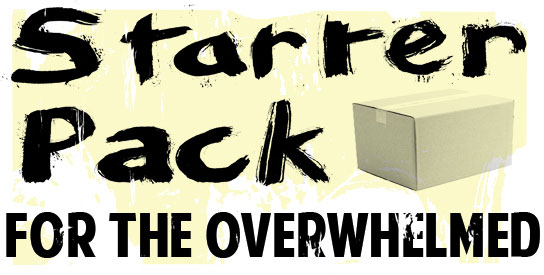 Lucio Fulci is not exactly an obscure name in horror. His movies are easily accessible and you’d be hard-pressed to find a horror fan that hasn’t seen at least a few of his films. If so much has already been said about Fulci, why make him the subject of the first post of Starter Pack for the Overwhelmed (and Mondo Exploito for that matter)? I have a few reasons. For starters, Fulci was one of my earliest entry points in the horror genre and I spent my teenage years obsessing over his films. Secondly, while most have seen the bulk of his goretastic classics (The Beyond, City of the Living Dead, The New York Ripper, Zombi 2, House by the Cemetery), many stop there. With a back catalogue of over fifty films, his filmography is certainly overwhelming, but with so many gems hidden throughout it’s a worthwhile journey. As his fans will tell you, Fulci was the master of genre hopping, despite his reputation for gory horror.
Lucio Fulci is not exactly an obscure name in horror. His movies are easily accessible and you’d be hard-pressed to find a horror fan that hasn’t seen at least a few of his films. If so much has already been said about Fulci, why make him the subject of the first post of Starter Pack for the Overwhelmed (and Mondo Exploito for that matter)? I have a few reasons. For starters, Fulci was one of my earliest entry points in the horror genre and I spent my teenage years obsessing over his films. Secondly, while most have seen the bulk of his goretastic classics (The Beyond, City of the Living Dead, The New York Ripper, Zombi 2, House by the Cemetery), many stop there. With a back catalogue of over fifty films, his filmography is certainly overwhelming, but with so many gems hidden throughout it’s a worthwhile journey. As his fans will tell you, Fulci was the master of genre hopping, despite his reputation for gory horror.
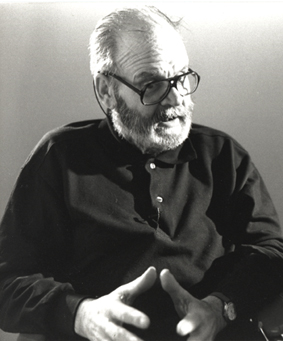 Lucio Fulci, based on accounts from members of his casts and crews, was quite the maniac. And if you’ve read any interviews with the man, you’ll know he likes to speak his mind (to quite hilarious effect at times). He had a reputation of being somewhat of a misogynist and supposedly hated actors treating them like dirt. (David Warbeck and Catriona MacColl tell us otherwise in the commentary for The Beyond.) While I’ve never found his movies to be particularly hateful towards women, the violence in his films – against both women and men – is undeniably insane and indulgent. I’m not complaining. Fulci would often point out in interviews that he could make better movies than Dario Argento if he was given the same budget. And I’d have to agree with that. In fact, I’d go further and say that Don’t Torture a Duckling is a better giallo than anything Argento made. (And this is coming from someone who worships Argento pre-1990s.) Fulci fascinates me because he was a classic tortured artist, even though he’d never call himself an artist. And despite his frustrations with his own work, his ever-lowering budgets and his jealousy of other filmmakers, Fulci continued to work into the 1990s making films that had “Lucio” written all over them.
Lucio Fulci, based on accounts from members of his casts and crews, was quite the maniac. And if you’ve read any interviews with the man, you’ll know he likes to speak his mind (to quite hilarious effect at times). He had a reputation of being somewhat of a misogynist and supposedly hated actors treating them like dirt. (David Warbeck and Catriona MacColl tell us otherwise in the commentary for The Beyond.) While I’ve never found his movies to be particularly hateful towards women, the violence in his films – against both women and men – is undeniably insane and indulgent. I’m not complaining. Fulci would often point out in interviews that he could make better movies than Dario Argento if he was given the same budget. And I’d have to agree with that. In fact, I’d go further and say that Don’t Torture a Duckling is a better giallo than anything Argento made. (And this is coming from someone who worships Argento pre-1990s.) Fulci fascinates me because he was a classic tortured artist, even though he’d never call himself an artist. And despite his frustrations with his own work, his ever-lowering budgets and his jealousy of other filmmakers, Fulci continued to work into the 1990s making films that had “Lucio” written all over them.
This regular article selects five films from a director or actor’s filmography for a virginal (and overwhelmed) viewer to begin with. The five films may be the director’s best or they may give the best summation of his work. I’ve opted for the latter option in the case of Fulci, which is why you won’t see masterworks like Beatrice Cenci, Contraband and A Lizard in a Woman’s Skin on the list. Here are five films that I believe give a decent coverage of the many directorial faces of Lucio Fulci.
Non si sevizia un paperino (Don’t Torture a Ducking), 1972
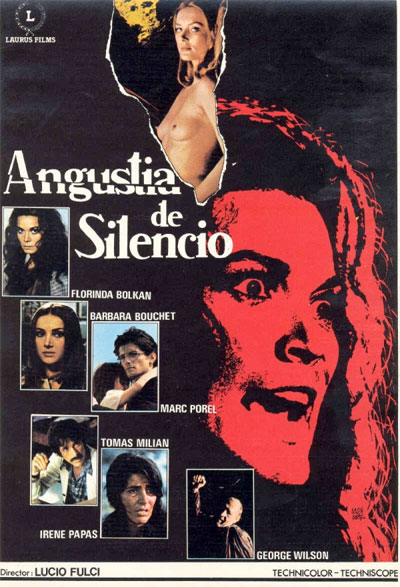
You may as well start with the best. When it comes to Fulci, it’s a toss between Beatrice Cenci and Don’t Torture a Duckling. But when choosing films that best represent Fulci as a filmmaker, Don’t Torture a Duckling is inescapable. While its odd title may receive a few giggles (it’s also known under the even funnier title Don’t Torture Donald Duck), Fulci keeps a straight face when delivering Don’t Torture a Duckling. Made a year after the seminal A Lizard in a Woman’s Skin, this is a vicious – and reasonably gore-free – film. The premise of murders in a quiet Italian village is nothing remarkable, but Don’t Torture a Duckling demands extra impact by having children as the victims. The murder scenes, while not graphic, are truly shocking and the famous scene of Florinda Bolkan receiving a horrific beating to the sounds of a pop tune still packs a mighty punch (and is still imitated today). Don’t Torture a Duckling is one of the best giallos ever made (if you ask me, it is the best). Fulci’s direction is tight, the script is focused and the film is stylised but not the the point of distraction. Don’t Torture a Duckling shows what Fulci was capable of given a good script and a great cast and crew. Fulci has also rated this as his personal favourite of his work in some interviews (I’ve heard him mention Beatrice Cenci in other interviews), which is a better endorsement than I could ever give.
L’aldilà (The Beyond), 1981
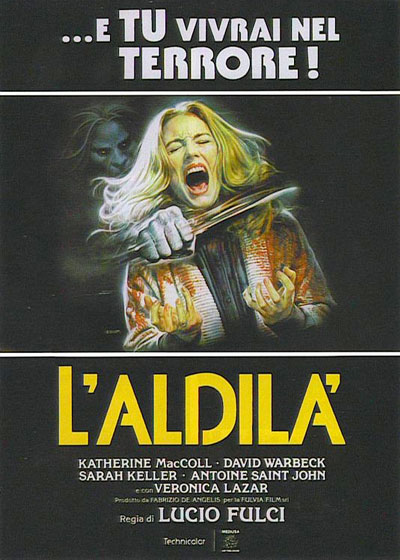
For all its cheesy fake spiders and incomprehensible plotting, The Beyond is a masterpiece of 1980s Italian horror. If I could choose one film to summarise Fulci’s golden age of gore and Gothic atmosphere, it would be this. The Beyond was my first experience with Lucio Fulci. Upon first viewing it, I was left feeling furious. I had no idea what I’d just watched. It felt more like a collection of ideas rather than a movie. But for the next few weeks, all I could think about was The Beyond. I ended up watching it again, only a fortnight after my first viewing. Somehow it all made sense second time around – even though its story didn’t – and thus began my obsession with Fulci. The more viewings I have of The Beyond – and that’s well into double digits now – the more I see it as not so much a narrative film but a celluloid nightmare. The Beyond has something that resembles a story, but character actions and plot turns seem more in tune with dream logic than your standard narrative structures. Visually, The Beyond is pure 1980s Fulci. Similar to The City of the Living Dead, the film is dark and hypnotic with billows of fog and sharp lighting captured by relentless camera zooms. In tune with the visuals is the eerie (and awesomely overbearing) score by Fabio Frizzi. The Beyond will coax gore-fiends in with its promise of grue, but will leave many of them mystified with the utter madness onscreen. It is the perfect example of why Fulci is equally loved and reviled.
All’onorevole piacciono le donne (The Eroticist), 1972
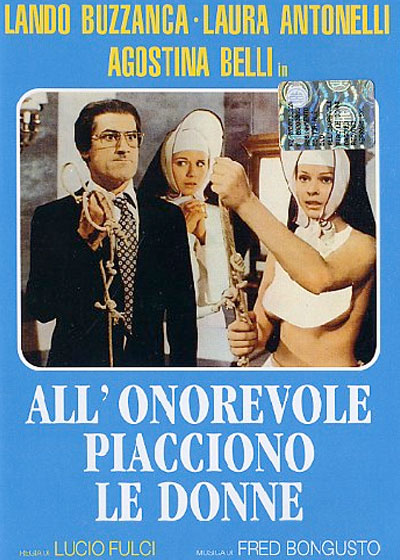
When I first began my mission to see everything that Fulci made in his long career, The Eroticist (or The Senator Likes Women) did not sound very appealing. The idea of Fulci directing a comedy – a sex comedy at that – seemed wrong. Little did I know that Fulci had directed many comedies early in his career. He was proud of these comedies; far more so than his iconic entries in the horror genre. Sadly, these early comedies are hard to find (I’m yet to see a handful of them). Luckily, The Eroticist was saved and released on DVD some years ago. It’s not from Fulci’s early career – it was released the same year as Don’t Torture a Duckling – but it is still an excellent film. What I found most shocking about The Eroticist upon first viewing it was that it made me laugh. Out loud. This is a genuinely funny movie. Fulci seems at home in the comedy genre. Another shocking revelation: The Eroticist – despite its goofiness – is rather clever. An IMDB plot outline of the film by Stefan Kahrs reads: “Senator Pupis feels a strong and uncontrollable urge to grab women’s bottoms, a habit that can lead to embarrassment, especially if the woman in question is head of another state and the occasion a state visit. In his desperation Pupis turns to the clergy for spiritual and psychological help.” Surrounding the ass grabbing from Senator Pupis (Lando Buzzanca) is an intelligent and strong commentary on Italian politics. Fulci, as he did in Don’t Torture a Duckling, also takes a nasty swipe at the Catholic church. The Catholics of Italy must have been out for Fulci’s blood in 1972. The ending of The Eroticist is perfection and a wonderful kick in the balls; certainly not your average sex comedy shtick. The Eroticist is proof of Fulci’s broad talents and a good introduction to his comedy work.
I quattro dell’apocalisse (Four of the Apocalypse), 1975
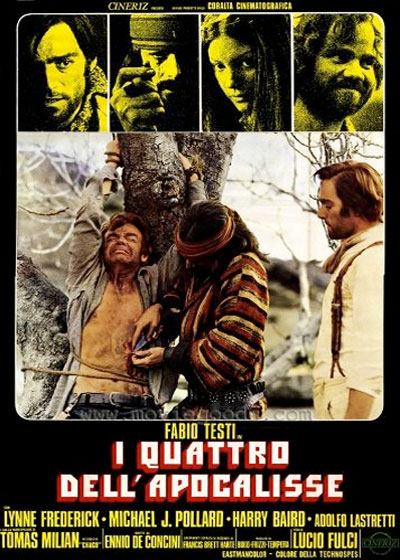
I love Spaghetti Westerns and would marry The Good, the Bad and the Ugly if it were legal. Fulci dabbled in the genre a few times – Massacre Time, I believe, is his first attempt (and a good one) – but by the time Four of the Apocalypse came along, audiences were tiring of Westerns (even though he’d give it another shot in 1978 with Silver Saddle). Even if Spaghetti Westerns were in favour in 1975, I can’t imagine Four of the Apocalypse being well received. Modern fans of Spaghetti Westerns seem to dislike it, but I love Four of the Apocalypse, and possibly for the same reasons it is so severely disliked. Four of the Apocalypse follows a group of four petty (and likable) criminals led by Stubby Preston (Fabio Testi). They wander through Utah in search of food and shelter, and along the way they are attacked by a psychotic bandit Chaco (the great Tomas Milian). Four of the Apocalypse has a bizarre sense of aimlessness about it. The characters float from one location to the next with little structure apparent. Odder still is the range of emotions and moods Fulci jumps between; this is quite the schizophrenic film. Four of the Apocolypse is brutal (especially when Milian is onscreen), but at times becomes strangely (and genuinely) sensitive. A truly bizarre and somewhat introspective Western that divides Fulci’s fans, Four of the Apocalypse shows another side of an eccentric filmography.
Voci dal profondo (Voices from Beyond), 1991
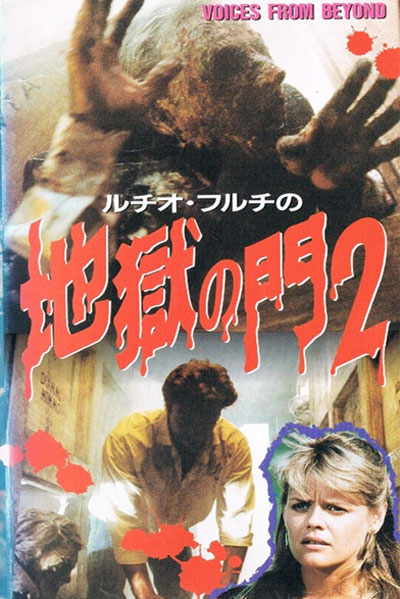
Fulci’s latter output – from the late 80s to 1991’s Door Into Silence – is often sneered at by horror fanatics. These films are seen as cheap and pale imitations of his former work. Other than a few stinkers (The Ghosts of Sodom is a truly awful film), I’d strongly disagree with this assessment. As Fulci’s budgets dwindled and as his regular cast and crew members left his side, his films became more personal than ever. A Cat in the Brain is an obvious example of this, and even the mental Touch of Death feels like something from Fulci’s home video collection. The best of these last few movies is Voices from Beyond. Feeling like an Italian soap opera at times, Voices from Beyond is the story of Giorgio Mainardi (Diulio Del Prete) who dies in the film’s opening leaving his horrible family to squabble over his riches. Mainardi’s spirit manages to communicate with his granddaughter Rosie (Karina Huff) through her dreams. Rosie attempts to uncover the truth of her grandfather’s suspicious death. Even though the film constantly cuts back to Mainardi’s rotting gooey corpse in its coffin, Voices from Beyond is a restrained affair. The film’s cheapness is apparent, but the script (co-written by Fulci) and direction rises above budgetary limitations. Shot through a hazy lens, Fulci injects as much style into the film as his meek budget allows. Voices from Beyond may contain its share of melodrama, but its story is engaging enough to overlook the flaws in the performances and dialogue. With Voices from Beyond (and Door Into Silence, released in the same year), Fulci muses over death with an obvious personal interest. Fulci’s 90s output may lack the spectacle of his previous work, but they are still clearly Fulci films. This is more than I can say for many horror directors of the 70s and 80s; filmmakers who all but forget what made their films great when 1990 rolled by. (Argento and Romero, I’m looking at you.)
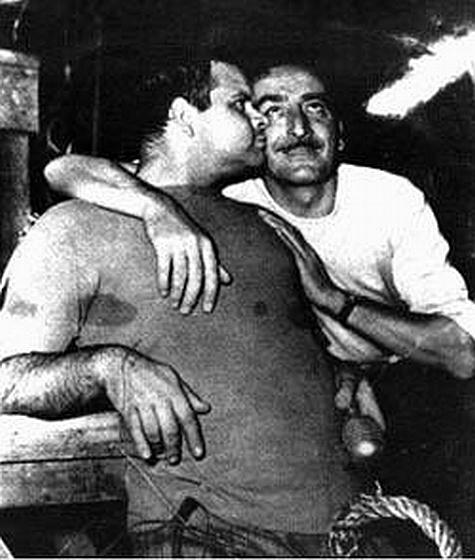 There are many films I’ve had to leave out of this article, but I believe that these five give a decent demonstration of Fulci’s abilities within different genres, different times and very different budgets. Fulci is a director who many scoff at. He’s been called a hack and his glorification of violence has been demonised with intense venom. But there are those of us who love his work. With a busy output spanning over thirty years, it’s easy to become obsessed with tracking down everything the man has made. It’s not an easy task, but – as someone who is still going down that path – it’s a very exciting and rewarding one.
There are many films I’ve had to leave out of this article, but I believe that these five give a decent demonstration of Fulci’s abilities within different genres, different times and very different budgets. Fulci is a director who many scoff at. He’s been called a hack and his glorification of violence has been demonised with intense venom. But there are those of us who love his work. With a busy output spanning over thirty years, it’s easy to become obsessed with tracking down everything the man has made. It’s not an easy task, but – as someone who is still going down that path – it’s a very exciting and rewarding one.
Here’s some Fulci films that I had to leave off the list that come highly recommended: City of the Living Dead, House by the Cemetery, A Lizard in a Woman’s Skin, Massacre Time, The New York Ripper, Seven Notes in Black, Zombi 2, The Devil’s Honey, Contraband, The Black Cat, Beatrice Cenci
Goofy but fun: Conquest, House of Clocks, Murder Rock, Touch of Death, A Cat in the Brain, Demonia, Aenigma
Avoid (unless you’re a completest like me): The Ghosts of Sodom, Manhattan Baby, The Sweet House of Horrors (pretty hilarious), Zombi 3




